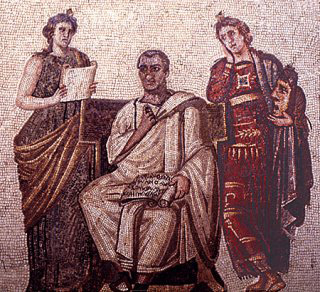Writing Assignments/Projects
Late submissions of assignments will be penalized.

1) The Romans Surf the ‘Net (due in class, Monday, February 4th)
Search the web to locate relevant sites to help answer the following questions. Print out images from, or home pages of, your selections, and on separate sheets of paper respond to the questions asked. Keep track of urls (web addresses) and be prepared to share them in class.
1) Find an image of the statue of any Roman emperor in a museum, anywhere in the world, that you find particularly ‘imperial looking’. Is it a statue of his entire body, a bust, or too broken to tell? What makes it look ‘imperial’ to you, at this point?
2) Find a map of the Roman Forum (aka the Forum Romanum). To get from the Regia to the Capitoline Hill (the Capitolium), which cardinal direction (N, S, E, W) do you go?
3) Find an opportunity to do archaeological fieldwork, on a Roman-period site. What kind of project looks good to you? (archaeologically intriguing? warm and sunny? good mud?) Hint: ‘fieldwork opportunities’ is a good starting point.
4) Find an example of a website devoted to Roman art and archaeology (in the broadest sense) that you find interesting, attractive, informative and reliable. What features led you to trust this as a source?
5) Find an example of a website devoted to Roman art and archaeology (in the broadest sense) that you found a little bit crazy, a little bit ‘out there’. What features led you to think it slightly wacko?
Final product should involve the equivalent at least one page of written work, and relevant print outs.
2) The Intellectual Uses of Russell Crowe — Gladiator (due in class, Wednesday, February 13th)
Watch the movie, ‘Gladiator’ (either privately or in the public showing by the Archaeology DUG on Wednesday, March 6th at 7 pm (Salomon Hall, Room 001). Identify an item of material culture (building, object, ‘thing’) that is important to the plot and structure of the movie, and write a brief explanation of what it is, and how and why your choice is so effective in the film’s context. Points for finding and discussing something a bit different: the Colosseum is a little obvious…
Final product should involve the equivalent at least two pages of written work.
3) Rome at the RISD Museum (due in class, Friday, March 14)
You are here given a ‘scavenger hunt’ to complete on a visit to be made, individually or in very small groups, to the Rhode Island School of Design Museum. In addition, select one artifact or art work on display that dates to the Roman period, and EITHER write a detailed description of it, explaining its style, craftsmanship and function (using readings for class, and independent research; we can supply bibliography) OR craft a fictional account (prose, poetry) that somehow involves or revolves around the piece — putting it back in its original Roman context, or retailing its history since ancient times. Be creative.
Scavenger Hunt at the RISD Museum
Rules of the game: Everyone is expected to go to RISD; no mooching off of other people!
The clues and questions below will lead you to specific objects on display in the Greek and Roman gallery. For each of the 5 objects you find, indicate the title given to it on its label, where it comes from (its provenance, if known), date(s), material of composition, and a very brief description (so we know we are talking about the same thing). The scavenger hunt is to accompany the main part of this assignment, as outlined in the syllabus and on the wiki (i.e. choose an object to write about…).
Good luck!
The Hunted:
1) While my specific identity remains unknown, my face is carved to look much like the princeps (not surprising, perhaps? I am a member of his family...)
2) Images (faces) that look like me became very popular in the Late Republic, clashing with the classicizing form of more idealized features. What am I and of what 'style' am I a good representative?
3) On perhaps the most imposing object in the gallery, what wall is being depicted?
4) In a cabinet of gold, I am unique (in material terms).
5) Objects like me were quite commonly found, before styles in post-mortem rituals (burial!) changed, beginning in the time of Hadrian.
Final product (apart from the ‘scavenger hunt’) should involve the equivalent at least three pages of written work.
4) Do It Yourself Rome (due in class, Wednesday, April 2nd)
Re-enact, and document for posterity, some aspect of ‘daily life’ in ancient Rome. Cook a Roman dish. Wrap yourself in a Roma toga or stola. Recreate a Roman funeral. Perform a mock Roman sacrifice. Play a Roman game. Anything as long as it doesn’t end in blood, death or dismemberment.
We might ask people to do re-enactments in class, but the assignment is to ‘try this at home’ and record it with video or photography, with a short written description of what lay behind your choice, how you did it, and how pleased you were (or surprised you were) by the result.
Bibliography to be drawn from the readings for class, or to be supplied as needed.
Final product should involve the equivalent of at least three pages of written work, as well as imagery.
5) Rome Rebuilt at Brown (due in class, Wednesday, April 16th)
Wander the Brown campus (and College Hill environs), locate and document (through video, photos, performance art, drawings or written descriptions) at least five places that are unquestionably influenced by Roman architectural models.
For inspiration, watch ‘Classical Providence: landscapes, monuments, rediscovery’ (http://pharos.brown.edu/classicalprovidence/embed.html) but extra credit to people who find examples not on display there.
Final product should involve the equivalent of at least three pages of written work, as well as imagery.
Course Requirements / Weekly Schedule / Assignments / Required Texts / Course Readings / Photo Credits / Lecture PowerPoints
